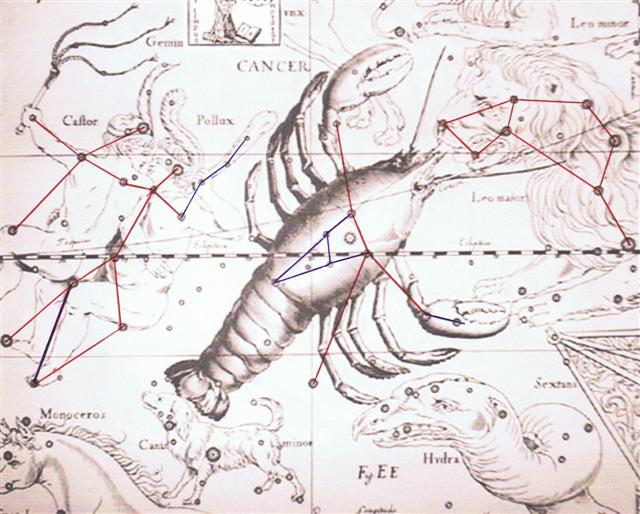|
4. The stars ε and μ Leonis are not the eyes of the Lion but his eyebrows (Al Ashfār), which I interpret is meaning his eyes are not open as yet. The expression a whip's length between them could be an allusion to how whips are used to make people come completely awake. The head of Leo has not yet reached 10h, and the quadrangle (like a piece of cloth) formed by κ, λ, ε, and μ is rising earlier than the front paw with Regulus:
Maybe the 10th hour implies Sun still is not present. If the cycle of Sun measures 10 months, then a new Sun should not arrive until the 11th ('one more') month. Instead of a new Sun rising there could be tightened 'strings' holding him back, and we can now appreciate why it was said that the Lobster's feelers were seen but not his body:
The stiff feelers of the Lobster are embracing the head of the Lion, thats why. In contrast the whip thongs held by Castor are flying freely - they are intended for the opposite purpose, to liberate. Neither the feelers of the Lobster nor the thongs of the whip are marked by stars, they are implements of the dark, cfr at The Sacred Jawbone: ... In China, every year about the beginning of April, certain officials called Sz'hüen used of old to go about the country armed with wooden clappers. Their business was to summon the people and command them to put out every fire. This was the beginning of the season called Han-shih-tsieh, or 'eating of cold food'. For three days all household fires remained extinct as a preparation for the solemn renewal of the fire, which took place on the fifth or sixth day after the winter solstice. The ceremony was performed with great pomp by the same officials who procured the new fire from heaven by reflecting the sun's rays either from a metal mirror or from a crystal on dry moss. Fire thus obtained is called by the Chinese heavenly fire and its use is enjoined in sacrifices: whereas fire elicited by the friction of wood is termed by them earthly fire, and its use is prescribed for cooking and other domestic purposes ... Like archaic China and certain Amero-Indian societies, Europe, until quite recently, celebrated a rite involving the extinguishing and renewal of domestic fires, preceded by fasting and the use of the instruments of darkness. This series of events took place just before Easter, so that the 'darkness' which prevailed in the church during the service of the same name (Tenebrae), could symbolize both the extinguishing of domestic fires and the darkness which covered the earth at the moment of Christ's death. In all Catholic countries it was customary to extinguish the lights in the churches on Easter Eve and then make a new fire sometimes with flint or with the help of a burning-glass. Frazer brings together numerous instances which show that this fire was used to give every house new fire. He quotes a sixteenth-century Latin poem in a contemporary English translation, from which I take the following significant lines: On Easter Eve the fire all is quencht in every place, // And fresh againe from out the flint is fecht with solemne grace. Then Clappers cease, and belles are set againe at libertée, // And herewithall the hungrie times of fasting ended bée ... The whip in Gemini is (according to Hevelius) held high above the head of Castor where there are no prominent stars:
From Castor to Pollux there are 2.8 days (slightly more than a whip's length):
Castor is the one who dies and 'flies' could rise above his head. There is a pair of weak manu rere preceding ihe tau - possibly they are leaving - and a single strong one - possibly arriving - at Ga2-22. There are events in the dark preceding the arrival of a new year. |
||||||||||||||||||||||||||||||||||||||||||||||||||||||||||||||||||||||||||||||||













